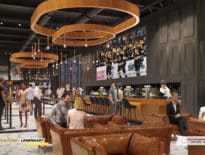
Carl Nagy-Koechlin
The accolades – and confetti – that have rained down on the Red Sox are well deserved. This year’s team, like the three other champions in the last 15 years, were talented and easy to root for. Ownership and the front office have been committed to and savvy about assembling these winning teams and should be praised for building the most successful baseball franchise of the 21st century.
Another key ingredient in the team’s success has been Fenway Park. The 105 year old “lyric little band box,” as John Updike called it, has been the setting for the team’s many championship heroics over these 15 years, and for inspiring moments like David Ortiz’s “it’s our f—ing city” speech in the aftermath of the marathon bombing.
There’s another less obvious but important role player in the team’s success and in the ballpark’s ongoing place in the life of the city: Fenway neighborhood activists and their allies at Save Fenway Park. It was this rag-tag coalition that helped prevent the demolition of Fenway Park and envisioned the improvements to the ballpark that are now integral to its charm, improved fan experience and enhanced profitability.
It’s hard to believe, and even harder to remember, that Fenway Park was within an inch of its life in 2000 when the then-Red Sox owners, with nearly unanimous support from Boston’s political and corporate establishment, advanced a plan to replace it with a cookie-cutter retro stadium. To justify their $350 million taxpayer subsidy “ask,” we were told that the team could never be competitive and would never end their championship drought without the new ballpark. In addition to the cost to taxpayers, the plan would have overwhelmed the diverse and thriving West Fenway neighborhood.
Undaunted by this high-powered juggernaut, community activists led by Fenway Community Development Corp. and their allies at Save Fenway Park went to work. They believed – rightly, as it turned out – that the best defense against the ill-conceived plan was a good offense. Rather than simply oppose the demolition of Fenway Park and the imposition of an out-of-scale new ballpark on the neighborhood, these activists offered a compelling alternative: A renovated and moderately expanded Fenway Park incorporated into a newly revitalized mixed-use “urban village” along the under-developed Boylston Street – all without a dime of public subsidy.
In the summer of 2000, the groups scraped together $65,000 to convene a dozen architects, planners, engineers and ballpark experts for an extraordinary week-long charrette where they devised ballpark renovation schemes along with neighborhood improvements. At the end of each day community residents were invited to see the progress and provide their input. The ballpark renovation plans included the Green Monster Seats, along with other features later adopted by the enlightened John Henry-Tom Werner ownership group.
We all know how this story ends: Fenway Park still stands with many upgrades that the Red Sox have masterfully incorporated into its historic fabric. The neighborhood around the ballpark is thriving, with several hundred new homes and businesses. The state and city treasuries were spared the raid that the Red Sox and their allies advocated. And – as hundreds of thousands of fans celebrated last week – the team has managed to win its fourth championship in what we were led to believe was the obsolete Fenway Park.
There’s an important takeaway from this history. While the Red Sox owners deserve all the credit they have received for saving and improving Fenway Park, pesky community activists and historic preservationists were also instrumental in this happy ending. They played a critical role in preventing a big and irreversible mistake.
Community input in the development process is usually assumed to be small-minded and misinformed, and often it is. I see it frequently in my organization’s efforts to develop affordable housing. But the David vs. Goliath struggle to preserve Fenway Park and to save the neighborhood from a new stadium offers a model for how community input can improve development plans for all parties, particularly when that input is not just against something but is also for something.
In this case everyone won: the neighborhood is intact and thriving, the taxpayers were spared, and the city retained its biggest tourist attraction. And, four championships later, it turns out the Red Sox can be competitive in the lyric little band box in the Fens.
Carl Nagy-Koechlin was the executive director of Fenway CDC from 1997-2009 and is currently the executive director at Housing Solutions for Southeastern Massachusetts.




 |
| 

